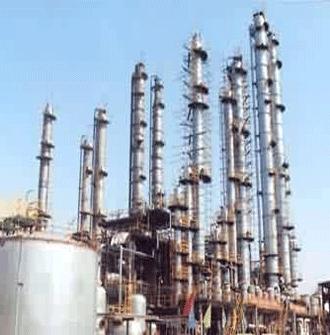Raw products from wellheads may be crude oil, with associated gas, water, and sand, or simply raw non-associated natural gas. The field operations cover the processing steps the raw wellhead product undergoes prior to entering the gas plant. These include the removal of sand, water, crude oil, and gas hydrates to prevent the pipeline from clogging, and an inlet compression to increase the pressure of the gas to allow it to flow across the plant.
Phase Separation
Crude oil from wellheads enters a slug catcher that removes slugs or any liquid phase from the gas by gravity. A slug catcher may range from a simple knockout vessel to sophisticated designs such as a finger type separator. The gas exits out the top, and the oil and water exit out the bottom.
The entering high-pressure feed undergoes a primary separation due to the difference in momentum between gas and liquid. Large liquid droplets impinge on the inlet wall and coalesce finer droplets. This knocks out a large portion of the incoming fluid. Then, as the gas velocities slow down within the middle part of the separator, gravity settling allows droplet fallout to occur. The gas continues to travel upward to exit the separator but passes through an insert that coalesces small mist particles together. The insert may be a wire mesh or a vane pack type mist eliminator. A wire mesh is roughly 6 inches thick and is mounted horizontally to the upward gas flow out of the separator. Vane packs are spaced corrugated plates that force the gas to follow a zig-zag pattern so that they coalesce into large particles as they collide with the plates. Cyclones may also be used as a coalescing filter using a centrifugal force that helps enhance separation of condensed phases from gas.
As the gas exits at the outlet on the top part of the separator, liquid is collected at the bottom and sent to a liquid-liquid separation unit to remove water and other solids from the hydrocarbon phase. The type of equipment used is similar for gas-oil separation but with a coalescing medium installed at a section before gravity separation occurs.
A typical slug catcher is either a horizontal or vertical separator vessel, but more sophisticated designs have been created and used in industry such as the manifolded piping slug catcher. The piping design allows higher operating pressures and is strictly used for catching liquid slugs. The number of pipes depends on the required volume and operating pressure of the unit but overall, it follows the same general process as a separator. The selection of a slug catcher configuration depends on the operating pressure, gas-liquid separation capability, liquid storage, and land requirements of the natural gas processing plant.
Condensate Stabilization
Condensates are hydrocarbons including pentanes and larger molecules. As they exit from the bottom of the phase separator, they still contain traces of contaminants that must be removed. A condensate stabilization unit includes a flash drum that operates at intermediate pressure and a fractionator with a reboiler. Any flashed gas exiting the flash drum is sent to the sour gas treatment while the flashed liquid is sent to the fractionator. The overhead vapor of the column is compressed and mixed with the flashed gas. Any remaining contaminants in the stabilized liquid condensates are subjected to further treatment for contaminant removal that will follow similar gas-treating processes.
Acknowledgments
- Scanning Technologies Inc
References
- Mokhatab, S.; Poe, W. A.; & Mak, J. Y. Handbook of Natural Gas Transmission and Processing. Boston: Gulf Professional Publishing, 2015, 191-217
- Kidnay, A.; Parrish, W. Fundamentals of Natural Gas Processing. Boca Raton: CRC Press, 2006
- Carroll, J. Natural Gas Hydrates – A Guide for Engineers; 3rd ed.; Elsevier, 2018.
- Engineering data book: volumes I & II: SI version; Gas Processors Suppliers Association: Tusla, OK, 2012.
Developers
- Nuramani Saiyidah Binti Ramli


